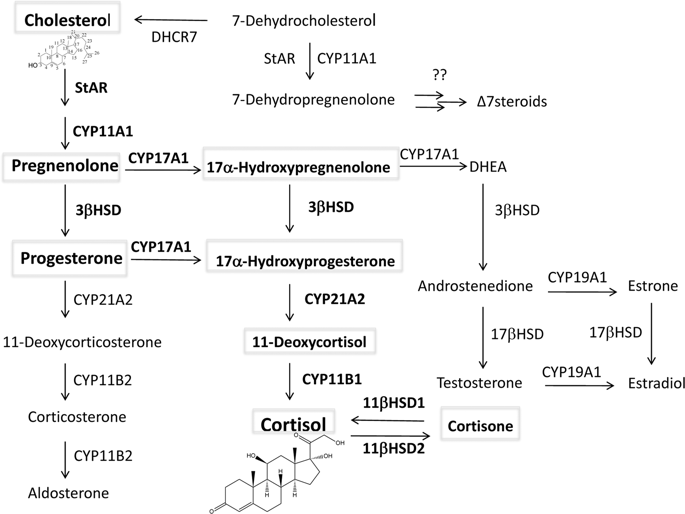Genes and Immunity ( IF 5.0 ) Pub Date : 2020-03-23 , DOI: 10.1038/s41435-020-0096-6 Radomir M Slominski 1 , Robert C Tuckey 2 , Pulak R Manna 3 , Anton M Jetten 4 , Arnold Postlethwaite 5, 6 , Chander Raman 1 , Andrzej T Slominski 7, 8, 9

|
Glucocorticoid synthesis is a complex, multistep process that starts with cholesterol being delivered to the inner membrane of mitochondria by StAR and StAR-related proteins. Here its side chain is cleaved by CYP11A1 producing pregnenolone. Pregnenolone is converted to cortisol by the enzymes 3-βHSD, CYP17A1, CYP21A2, and CYP11B1. Glucocorticoids play a critical role in the regulation of the immune system and exert their action through the glucocorticoid receptor (GR). Although corticosteroids are primarily produced in the adrenal gland, they can also be produced in a number of extra-adrenal tissue including the immune system, skin, brain, and intestine. Glucocorticoid production is regulated by ACTH, CRH, and cytokines such as IL-1, IL-6, and TNFα. The bioavailability of cortisol is also dependent on its interconversion to cortisone, which is inactive, by 11βHSD1/2. Local and systemic glucocorticoid biosynthesis can be stimulated by ultraviolet B, explaining its immunosuppressive activity. In this review, we want to emphasize that dysregulation of extra-adrenal glucocorticoid production can play a key role in a variety of autoimmune diseases including multiple sclerosis (MS), lupus erythematosus (LE), rheumatoid arthritis (RA), and skin inflammatory disorders such as psoriasis and atopic dermatitis (AD). Further research on local glucocorticoid production and its bioavailability may open doors into new therapies for autoimmune diseases.
中文翻译:

肾上腺外糖皮质激素的生物合成:对自身免疫和炎症性疾病的影响。
糖皮质激素的合成是一个复杂的,多步骤的过程,首先是通过StAR和StAR相关蛋白将胆固醇输送到线粒体内膜。在这里,它的侧链被CYP11A1切割产生孕烯醇酮。孕烯醇酮被3-βHSD,CYP17A1,CYP21A2和CYP11B1酶转化为皮质醇。糖皮质激素在调节免疫系统中起关键作用,并通过糖皮质激素受体(GR)发挥作用。尽管皮质类固醇主要在肾上腺产生,但它们也可以在许多肾上腺外组织中产生,包括免疫系统,皮肤,大脑和肠。糖皮质激素的产生受ACTH,CRH和细胞因子(例如IL-1,IL-6和TNFα)的调节。皮质醇的生物利用度还取决于其与可的松的相互转化,通过11βHSD1/ 2无效。紫外线B可以刺激局部和全身性糖皮质激素的生物合成,这说明了其免疫抑制活性。在这篇综述中,我们想强调的是,肾上腺糖皮质激素分泌异常可能在多种自身免疫性疾病中发挥关键作用,包括多发性硬化症(MS),红斑狼疮(LE),类风湿关节炎(RA)和皮肤炎性疾病如牛皮癣和特应性皮炎(AD)。对局部糖皮质激素产生及其生物利用度的进一步研究可能会为自身免疫性疾病的新疗法打开大门。我们要强调的是,肾上腺糖皮质激素分泌异常可能在多种自身免疫性疾病中发挥关键作用,包括多发性硬化症(MS),红斑狼疮(LE),类风湿关节炎(RA)和皮肤炎性疾病,例如牛皮癣和特应性皮炎(AD)。对局部糖皮质激素产生及其生物利用度的进一步研究可能会为自身免疫性疾病的新疗法打开大门。我们要强调的是,肾上腺糖皮质激素分泌异常可能在多种自身免疫性疾病中发挥关键作用,包括多发性硬化症(MS),红斑狼疮(LE),类风湿关节炎(RA)和皮肤炎性疾病,例如牛皮癣和特应性皮炎(AD)。对局部糖皮质激素产生及其生物利用度的进一步研究可能会为自身免疫性疾病的新疗法打开大门。





















































 京公网安备 11010802027423号
京公网安备 11010802027423号